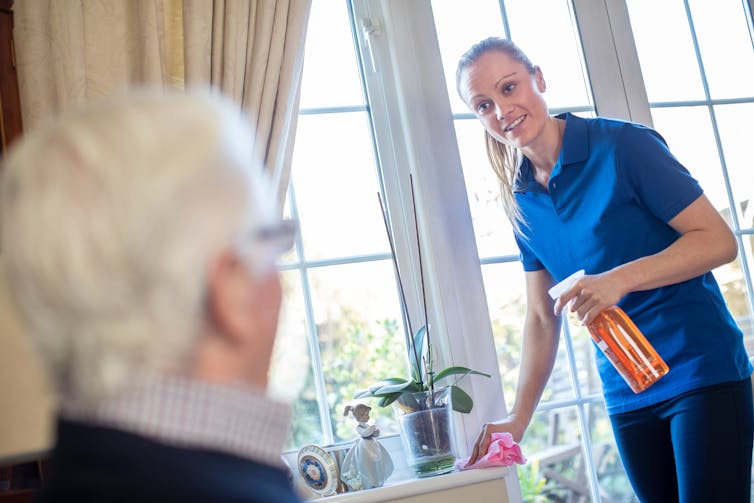Waiting lists for older people who need home care have blown out again. Twice as many people are now waiting for a Commonwealth Home Care Package as last year.
Home care packages help older people with more significant needs to live independently at home and in the community.
Four levels of care are available. Level 1 provides up $10,000 per year for services such as allied health, social support and transport with limited assistance for housework and meals. Level 4 provides up to $60,000 per year for personal and social support and a range of health services for older people with complex health, personal and social needs living at home.
An aged care assessment is required to get a package. Packages are means tested and users are expected to contribute a daily fee, income tested fees and additional fees for services not covered by their package.
But the federal government caps the number of home care packages it provides. When demand exceeds supply, waiting times blow out.
Too few packages are available
In December 2023, 270,000 older people had a home care package – an increase of 14% since December 2022.
But demand for home care packages continued to grow much faster than the increase in the number of packages. The number of people on the waiting list increased from 30,000 to 51,000.
That would not be a problem if waiting times were acceptable. But they aren’t.
Once older people are assessed as eligible, it takes around one to three months to get a level 1 or 2 package, but more like 12 months to get a more intensive level 3 or 4 package. This doesn’t include the two to six weeks it takes to get an aged care assessment.
The problem continues to grow. The most recent estimate is that almost 70,000 older people are now waiting for a home care package.
What do older people do while they wait?
Often, people who need a package muddle along for long periods with help from family, friends and local community services.
Because of the shortage in home care packages, people are offered lower package levels or basic services provided by the Commonwealth Home Support Program while they wait for their approved package.
This has serious consequences. Long waiting periods for home care packages can lead to deterioration in health, increased pressure on families, hospital admissions, unnecessary entry to residential care and reduced quality of life.
Around 8,000 people died while waiting for a package in 2020-21 and a further 11,000 entered residential care instead.
Why is demand increasing?
The increase in demand for home and community care is partly due to demographic ageing. Australia is rapidly becoming older. In the 1970s around 8% of the population was aged over 65.
By 2026 it will be more than 22%. This will see a rapid increase in the number of people aged 80 and over (the highest users of home care) in the next ten years.
But other factors including increased living costs, reductions in the availability of informal care and older people’s preference for care at home rather than in an institution are also important.

Daisy Daisy/Shutterstock
Serious problems with home care packages are not new. In addition to problems with long waiting times, getting access remains complex and cumbersome.
There has been a proliferation of home care providers without the development of a local or regional management structure to safeguard older people’s interests.
There are also concerns about value for money and low levels of training for home care staff.
Most of these issues were identified in the Royal Commission on Aged Care Quality and Safety, which concluded in 2021.
What did the commission recommend?
Most importantly, the commission recommended a timely, universal entitlement to aged care to guarantee access to the level of care and support each older person needs.
For home care, the commission recommended a streamlined assessment process to improve access via:
- a single home care program that combined the current support and package programs to be introduced by this year
- a new funding model consistent with the funding that would be available if the person entered residential care
- a number of additional service improvements, including access to allied health.
The federal government has failed to meet the commission’s basic recommendation that older people get access to the level of care they need within one month.
The proposed new home care program has not been implemented, streamlined assessment is not in place, waiting lists and times continue to blow out and the new system design has not been settled.
Add to that the proliferation of home care providers, difficulties in attracting and retaining staff and little progress on requirements for training, supervision and staff development.
Overwhelmingly, older people want to live independently at home for as long as possible. In the short term, the federal government should match demand and supply for home care packages.
In the medium term, it needs to get on with implementing the recommendations of the royal commission with much greater urgency.
Hal Swerissen, Emeritus Professor of Public Health, La Trobe University
This article is republished from The Conversation under a Creative Commons license. Read the original article.









